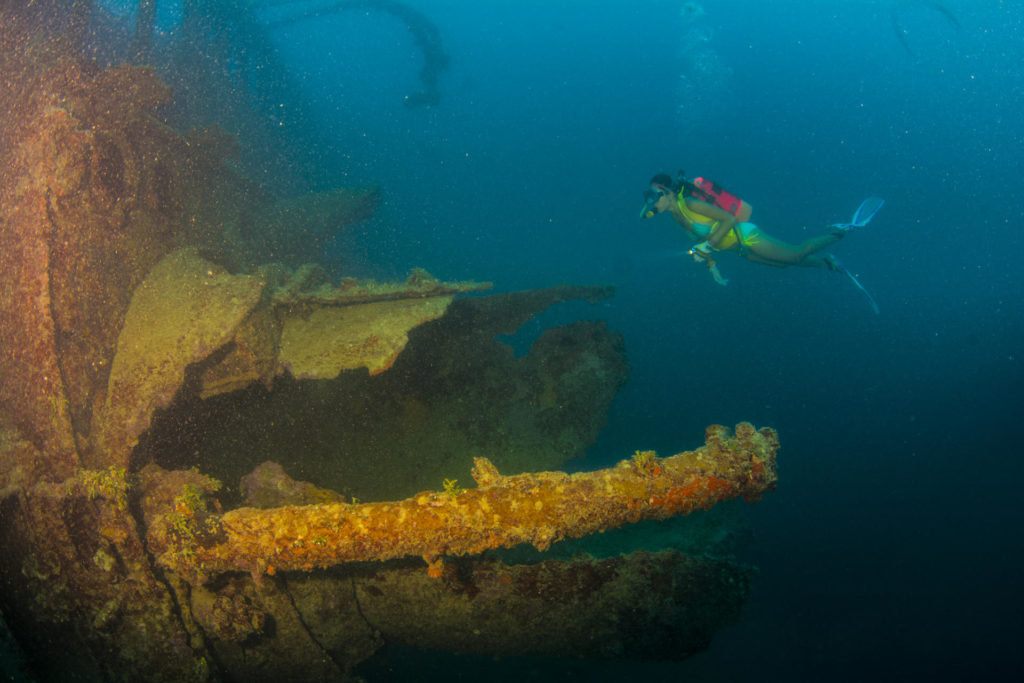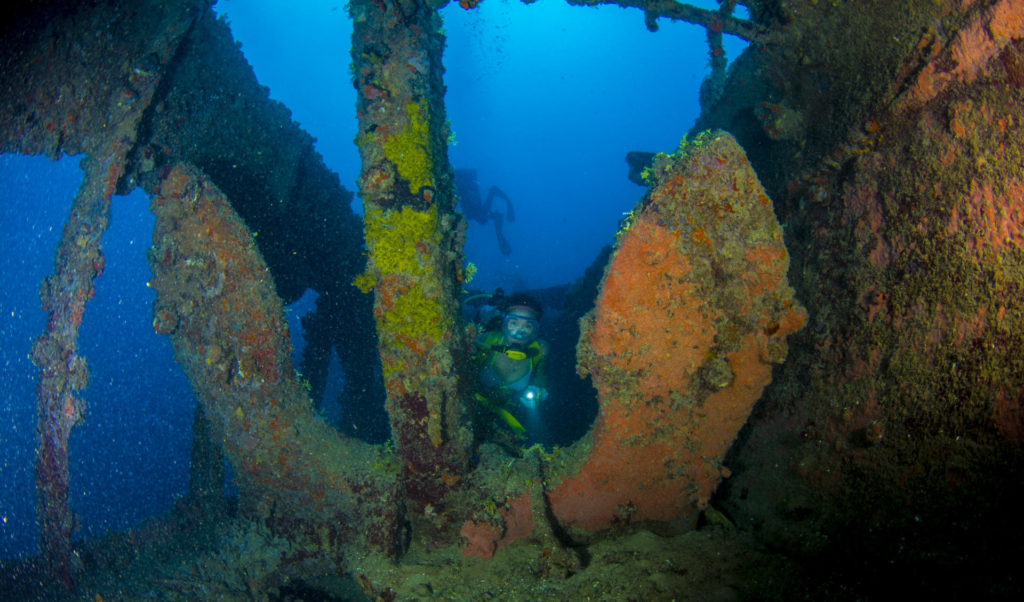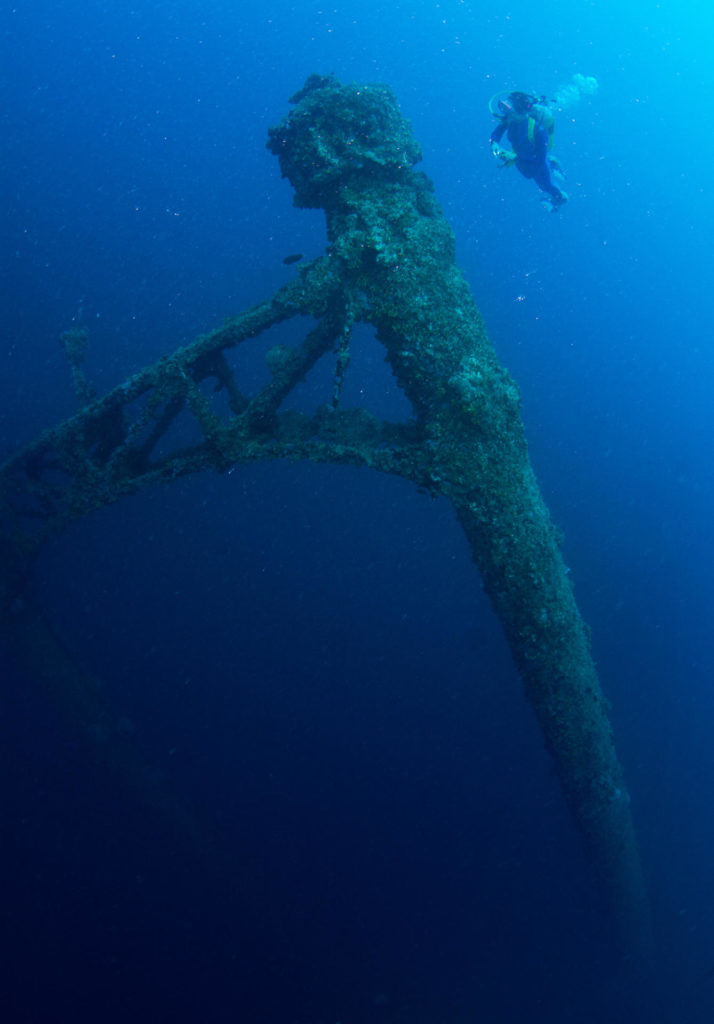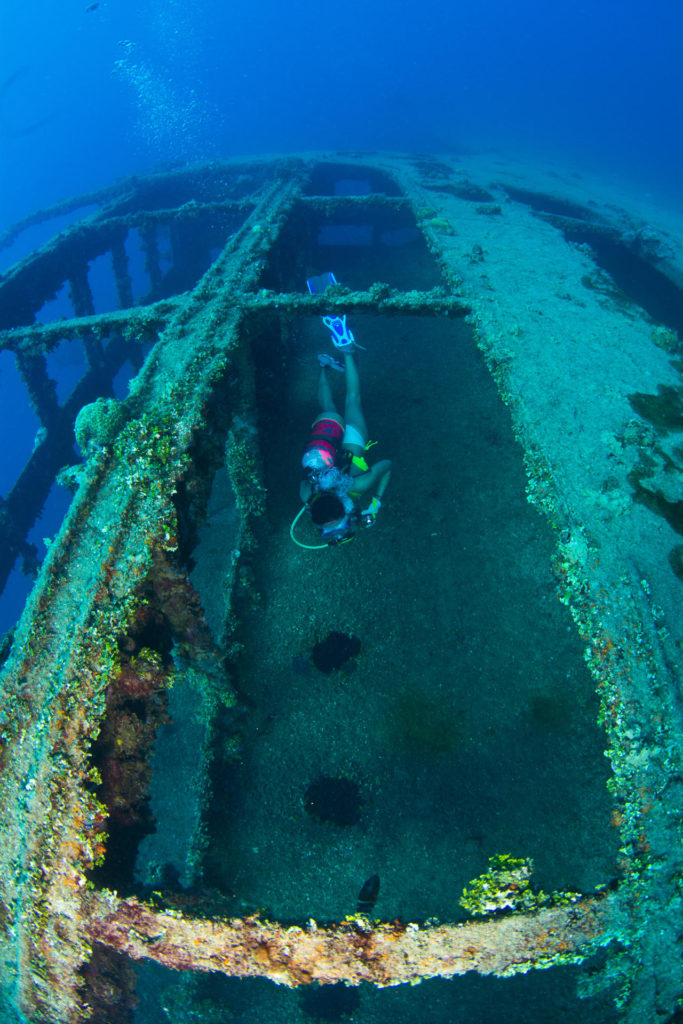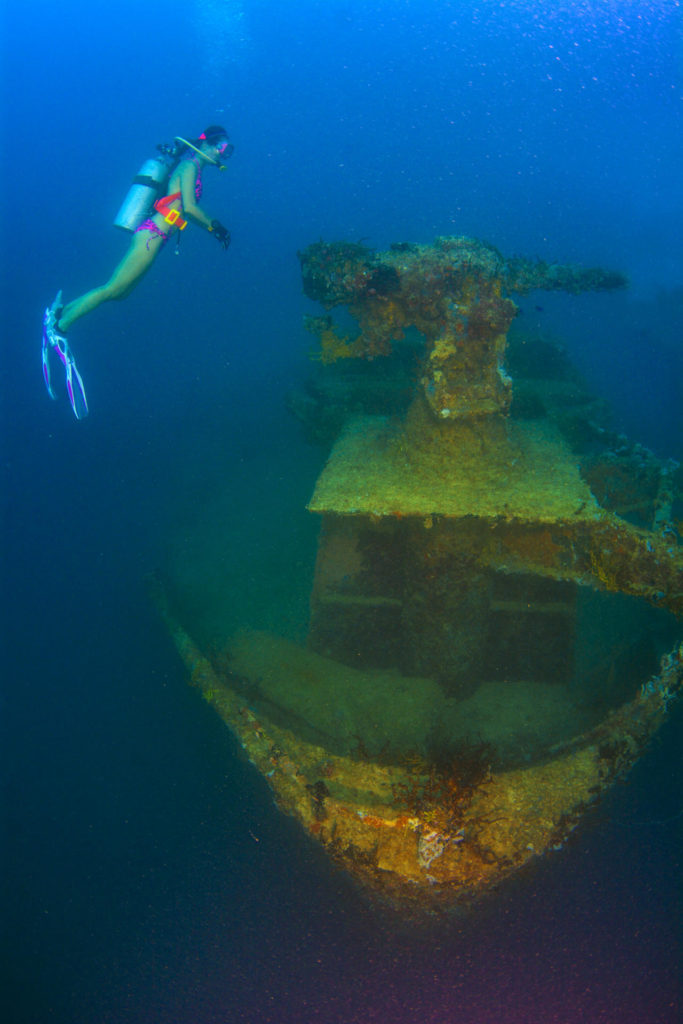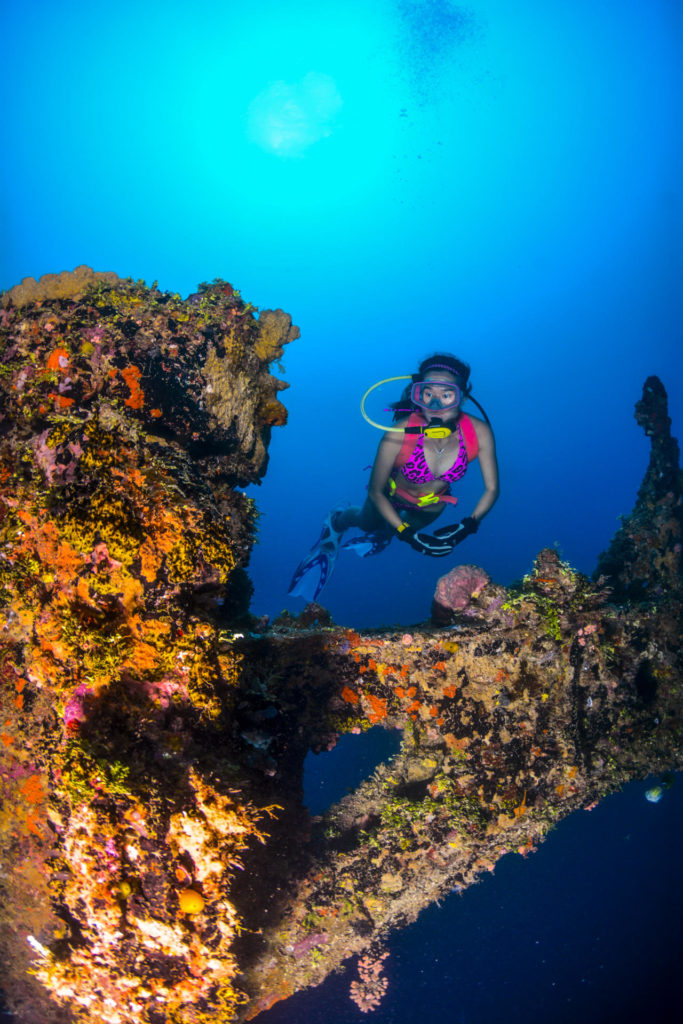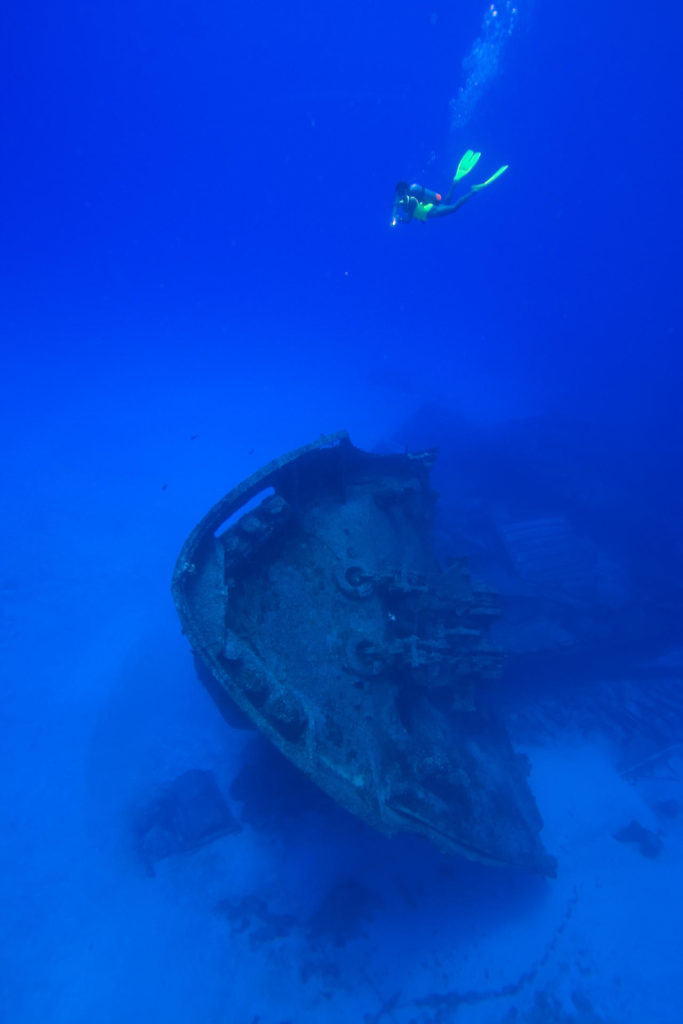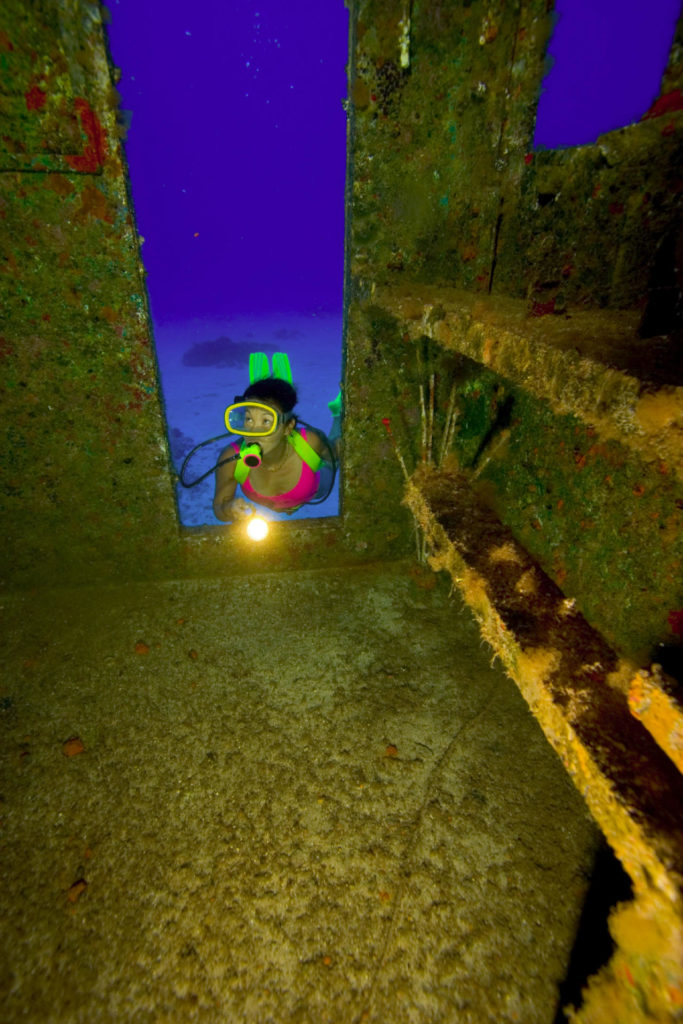In the wreck department, Guam has five large war-era wrecks in its Apra Harbor, and there are at least 60 types of these war remnants in the harbor, ranging from a Harley motorcycle to amtracs and tractors to lost airplanes. One of the most popular sites is a WW I-era German shipwreck resting on the sea floor with a WWII Japanese shipwreck resting above it. The ships, remnants of the two great wars, touch near their aft sections. Not only do the wrecks provide a look back in history, but they also provide a habitat for a number of fish species and a place for corals and sponges to grow.
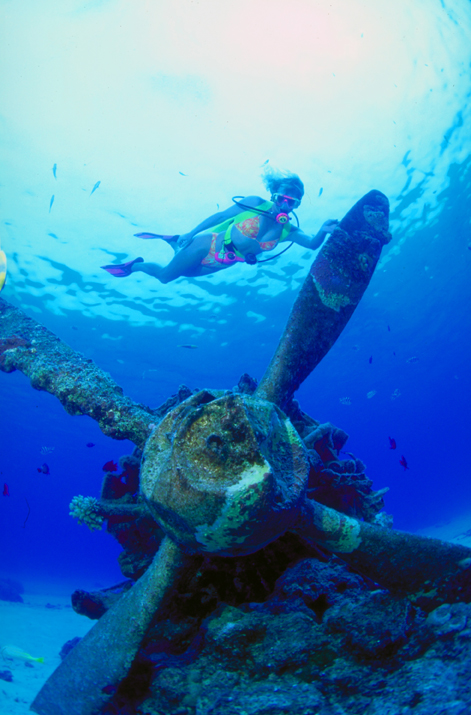
SMS CORMORAN
The Cormoran and crew sat at peace in the Guam harbor for many months until the USA declared war on Germany. The German captain, to avoid capture, scuttled this ship and some of the crew went down with it at the start of WWI. They are buried in East Agana in the seaside cemetery there. One of diving’s unique sites, the Japanese Tokai Maru rests next to and above it. It is the only site in the world where wrecks from two world wars touch one another. A diver can go aft of the Cormoran to see this spot.
Sitting on the starboard side, the ship can be penetrated (please follow a trained guide) so divers can see the engine room. The engine room hatches have been propped open, and divers who are familiar with penetration dives can explore the engine and the walkways.
There is also a lion claw bathtub deep within the ship. Since the ship is on its side, disorientation can occur, so divers need to take care. This is a deeper dive but quite interesting in its older design. The ship was built in 1909.
For those not trained in shipwreck penetration, the overswim of this classic old ship is a great experience. There is not much coral growth on the Cormoran even after all of these years. So it makes her early 1900s features easy to see. Decompression can be done above on the Tokai Maru.
TOKAI MARU
The Tokai Maru was a Japanese passenger and freight steamer built in 1930. The Tokai was anchored in Apra Harbor in January of 1943. Back then the Glass Breakwater didn’t exist, and submarines could sneak close to the mouth of the harbor.
It was torpedoed at sea and damaged by the U.S. submarine Flying Fish, so it limped into Guam and awaited repair. Seven months later, a second U.S. submarine, Snapper, torpedoed it and sunk it. It went down at the same anchorage as the German WWI ship SMS Cormoran.
The Tokai is generally shallower than the Cormoran but much longer, so a full overswim can take up an entire dive. With a large bridge area and lots of holds, it is great to explore for a second dive after making a deeper dive on the Cormoran. Those familiar with penetration can go inside the large bridge area here and see the remains of galleys, latrines, sinks and even tile floors. One should be very careful, as it is silty. Also, the penetration into places such as the engine room is very difficult and should only be done with proper training. The bow also is covered in salmon and brilliant yellow tubastrea corals and is very pretty on a night dive. This ship has lots of fish life out in the blue water.
KITSUGAWA MARU
Nearby Guam’s twin wrecks is an upright ship with an intact bowgun. This WWII ship sits upright in the main shipping channel. Divers normally descend the forward mast and then move toward the bow of the ship. The bow is still largely intact and is a very photogenic spot for underwater photographers wanting to capture the essence of a war wreck.
It has a bowgun that still has boxes of ammo placed on the gun’s turret. There are one or two holes where ammo was taken from the boxes. Look for octopus to be residing in these holes.
A leisurely swim back to the mast and then on to the bridge can bring a look at sea life such as batfish and bannerfish. There is some damage to the ship that isn’t war-related, as this ship has gotten tangled in the anchor chains of some fishing and cargo ships.
The aft was pretty much blown away when it was attacked. Explore the bridge and then slowly ascend the kingposts and forward mast. Brilliant sapphire damsels and encrusting sponges have made these upper structures into small reefs.
Apra Harbor was a busy place as a big staging area after liberation by the United States, so the harbor is a real treasure trove for divers wanting to explore its waters.
AMERICAN TANKER
One popular dive inside the breakwater is the American Tanker. A very fishy wreck, this big water tanker is also a vicitim of WWII. This tanker was probably sunk here on purpose after the war as part of the building of the barrier peninsula called the Glass Breakwater.
Prior to the war, the breakwater area was just a low sand bar and coral reef. The military built up this long peninsula using rocks, debris, military junk and just about anything it could. The entire northern peninsula in the harbor was built after the war, and there are small wrecks, barges and other remnants all along this break.
Descending the buoy line to the ship, an open “bridge” area and massive rudder make the aft fun to explore. Dive guides sometimes feed fish here, and there are lots of fish to greet divers as a result.
This ship should not be entered, as the inside is massive and pitch black and not for sport diving. But the various structures on the deck hold fish life, and the bow has various coral. Look for the big, blue elephant ear sponges on the ship. Also, if you are into tiny things, skeleton shrimp can be found on the tunicates that grow on the sides of the tanker. The reef next to the tanker is great to explore. A fourpound nudibranch, the largest of the nudis, was found along here a couple of times. There are healthy hard corals on the reef and also growing on the side of the ship. West of the American Tanker is the SeaBee Junkyard. This dump site was part of the fill of the Glass Breakwater at the end of the war. There are bulldozers, trac vehicles, big pipes and all other sorts of things that attract fish and invertebrate life.
It is shallow at the top of the site and can be explored for a long dive. Fish like this protective cover and angelfish, many kinds of butterflyfish and lots of puffers can be found around the various pieces of wreckage.
MARIANAS WRECKS
Rota is a stunning natural isle in the Northern Mariana Islands known for its clear water and natural setting. For divers, an amazing cathedral of blue beauty awaits. Rota is known as the friendliest island in the Marianas. Rota’s residents seem to always have a smile. Everyone waves or nods at everyone else as they pass on the road. This is an island tradition.
Rota is just 30 miles by air north of urban Guam. It offers a great deal for the diver, hiker and escapist. This outpost is a reward in natural beauty, undersea treasures and local Chamorro culture.
SHOUN MARU & SEVEN SCREWS
The WWII Japanese freighter Shoun Maru has been Rota’s premier wreck dive for decades and, though the ship is showing some sign of age, she attracts a healthy selection of marine life and her big bow still cuts a pretty profile. The ship is upright and splayed wide open. The bow still sits high in the water. On most days the diver can see the entire 400-floor long wreck from the surface. Amazing.
There is also the Seven Screws wreck. This ship was sunk for sport diving but once plied the rivers of China. It was confiscated at part of a human smuggling arrest. The seabed around both wrecks is alive with garden eels. The ships attract whitetip sharks and spadefish like the water around the Shoun Maru.
SAIPAN
The island of Saipan is the capital of the Commonwealth of the Northern Mariana Islands (CNMI) and is a quick trip by jet from most Asian airports. The PIC hotel on the west coast of Saipan has a large water park, punctuated by a replica of an ancient Manila galleon, a tribute to a gold ship that sank on the nearby coast. But whether it be treasure or bountiful marine life, Saipan is a place that holds many secrets beneath its sea.
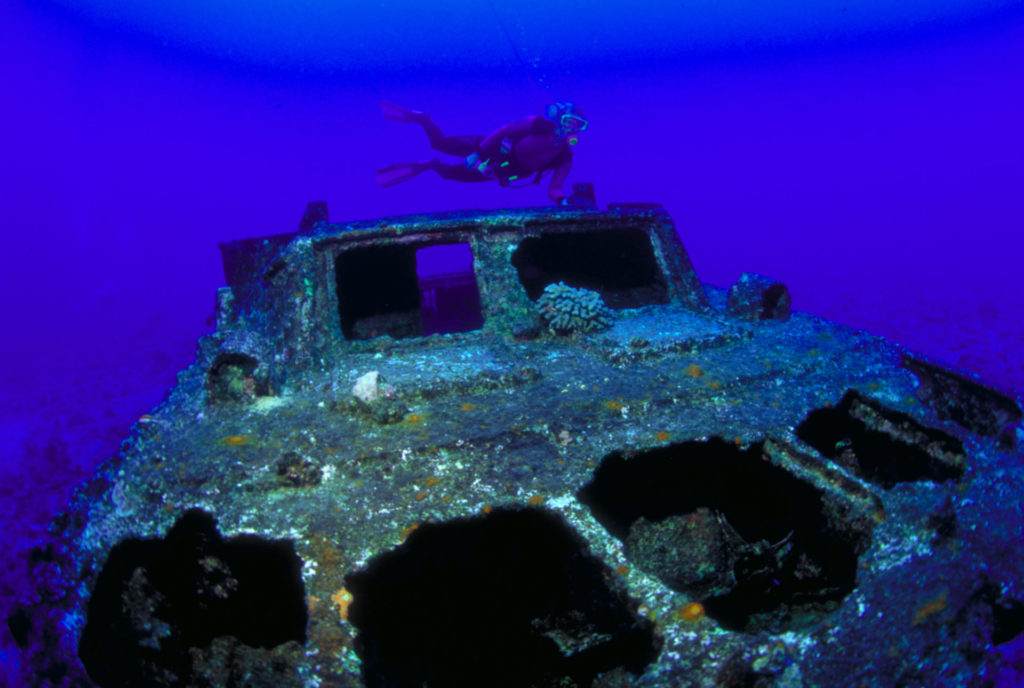
The island is famous for clear water. Divers are now coming to see a new underwater attraction, schooling eagle rays off Managaha Island. Tanapag Harbor holds most of the island’s wrecks and war planes.
TANAPAG WRECKS
A couple of WWII airplane wrecks complete with whitetip sharks and resident eels sit in shallow waters in Tanapag.
Big propellers stand high in the sand. There are also a couple of wartime shipwrecks (one also called Shoun Maru) in shallow water clouded with schools of goatfish and snappers.
One is badly damaged, as it was used by the CIA in the cold war years for target practice. But it is a great natural reef. Aside from the large schools, there are sleeping sharks under the metal, and an eagle ray can swim by.
The islands of Guam and the CNMI are a great getaway for the diving enthusiast. Tinian, across a channel from Saipan, also offers some cool dives. Check out these islands for a great commune with history and nature.
Guam resident Tim Rock is an internationally published marine photojournalist whose work can be seen through Getty Images. He is a Lonely Planet author and also has his own Guam-based publishing company. Website: timrock.photoshelter.com





